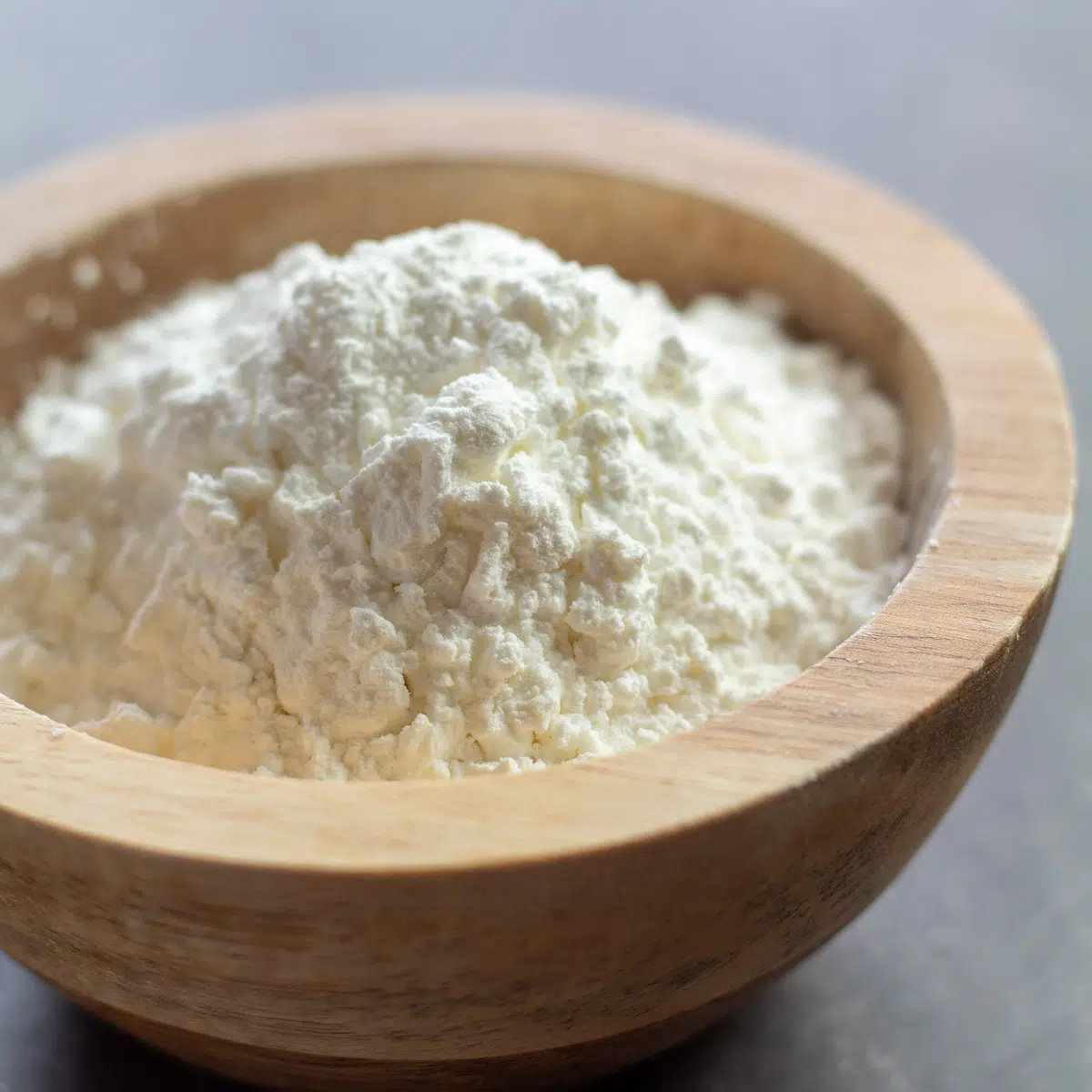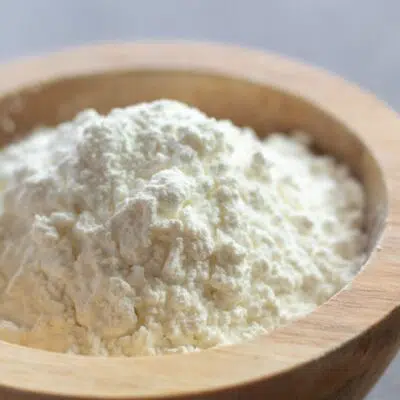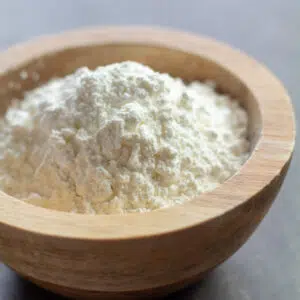Finding the perfect cornstarch substitute isn't difficult with my all-inclusive guide to the best cornstarch replacements! Don't settle for watery soup and sauces, try using some of these ingredients to thicken them up when you're out of corn starch!

Cornstarch is often an essential ingredient, find the perfect replacement with one of these 15 options!
Many of our favorite meals wouldn't be the same without cornstarch. The perfect gravy at Thanksgiving or a thick hearty soup on a cold winter night.
Cornstarch is the ingredient that allows for that rich and creamy thickness of many favorite soups, sauces, and sides.
Jump to:
- What is Cornstarch?
- Best Cornstarch Substitutes
- 1. All-Purpose Flour
- 2. Rice Flour
- 3. Almond Flour
- 4. Arrowroot Powder
- 5. Potato Starch
- 6. Tapioca
- 7. Cassava Flour
- 8. Ground Flaxseeds
- 9. Psyllium Husk Powder
- 10. Sorghum Flour
- 11. Xanthan Gum
- 12. Guar Gum
- 13. Glucomannan
- Other Thickening Options
- 14. Blended Veggies
- 15. Greek Yogurt or Sour Cream
- 16. Heat Reduction
- 📖 Recipe Card
- 💬 Comments & Reviews
What is Cornstarch?
There is not a whole lot to cornstarch. It is essentially just the starch that is removed from corn and put into a powder form.
The final result of corn starch is a compound that expands when it comes into contact with liquid. This is what makes it such a great thickening agent for sauces and soups.
Best Cornstarch Substitutes
The great thing about cornstarch as a kitchen staple is that it is inexpensive to buy, and you don't need to use a lot in a recipe. So, you can usually buy a large bottle and have it on hand for quite a while.
Unfortunately, sometimes with pantry staples like this, since we don't need to buy it frequently, we often forget when we do run out. If this happens, just take a peek into the pantry and see if you can find one of these equally great substitutes.
1. All-Purpose Flour
The easiest substitute for cornstarch is all-purpose flour. Flour is used as a thickener in many of the same recipes that cornstarch is used for. The great thing about this option is that most people already have flour on hand.
Use a 2:1 ratio of flour for cornstarch in any recipe: 2 tablespoons of flour for 1 tablespoon of cornstarch. Like cornstarch, you want to add liquid to the flour before adding it to the recipe. This helps avoid getting any clumps of flour in your dish.
Mix the flour in a small cup or bowl with cold water and whisk or stir briskly to get all clumps out. Slowly add this to your soup, sauce, or gravy.
When you reach the desired consistency, you can stop adding the flour. The one drawback of using flour is that it is not gluten-free. If you need a gluten-free option, the rest of these substitutes are for you.
2. Rice Flour
Rice flour is made from milled rice. It has a similar consistency to wheat flour which makes it a great alternative as a thickener where wheat flour also works well.
For example, rice flour does well under heat. This makes it a good gluten-free alternative for sauces or stews that will be simmering for a long time.
Use rice flour in 2:1 substitution for cornstarch: 2 tablespoons of rice flour for 1 tablespoon of cornstarch. Like all-purpose flour, it is best to mix this with a bit of water before adding it to the dish.
3. Almond Flour
If you have a gluten sensitivity, then you probably have almond flour (or another nut flour) in your pantry. Almond flour can be used in a similar way to all-purpose flour as a cornstarch substitute.
Replace cornstarch with an equal amount of almond flour in a 1:1 ratio. Almond flour does not clump as easily as wheat flour, so you can often do okay to just whisk it directly into the recipe. However, if you want to be sure you get a smooth outcome then mix it with a little water to create a sludge before adding.
One thing to keep in mind with almond flour is that it will offer a nutty addition to your dish. So, it works best with hearty stews or dishes that will pair well with the earthy qualities of the almonds.
4. Arrowroot Powder
You may or may not be familiar with arrowroot powder (or flour), depending on your dietary preferences. Like almond flour, it has become popular as a gluten-free alternative in baking.
It is also a popular choice for those who follow a Paleo or Keto Diet. As a cornstarch substitute, it works well for recipes where you don't want to change the flavor (which will happen with almond flour).
Even if you don't already have this in your pantry, it is quite common and easy to find in the grocery store. Many mainstream stores now carry it on their baking aisle.
Use arrowroot in a 2:1 ratio as a substitute in any recipe that calls for cornstarch: 2 tablespoons of arrowroot for 1 tablespoon of cornstarch.
5. Potato Starch
Similar to the way the starch is removed from corn to make cornstarch, potatoes are smashed, dried, and then milled into a powder to create a starch derivative. While potato is another gluten-free option and Paleo friendly, it is not a low-carb friendly substitute.
Potato starch is not commonly found in mainstream grocery stores, but you can find it in a specialty health food store or order online. Easily swap out cornstarch for equal parts potato starch in a 1:1 exchange.
One thing to be mindful of when using potato starch is that it thickens quite quickly. Therefore, add it slowly towards the end of the cooking process or it may thicken up too much.
6. Tapioca
If you have a tapioca pudding lover in the house, then you may already have this option on hand! The tapioca pearls used to make pudding are a great substitute for cornstarch. You can also find tapioca in powder or flake form.
Like potato starch, tapioca is another great gluten-free option that is not low-carb. However, tapioca is more commonly found in mainstream stores.
Use tapioca (pearls, powder, or flakes) in a 2:1 exchange for cornstarch: 2 tablespoons of tapioca per 1 tablespoon of cornstarch.
7. Cassava Flour
While tapioca is a familiar ingredient for many people, even if they don't regularly use it, cassava flour is one that is just recently becoming more popular. However, tapioca comes from the cassava plant!
Tapioca is derived from a process of washing and pulping the cassava plant. Cassava flour is simply the result of grinding up the cassava root into a powder.
Cassava has a mild taste and works well as a thickening agent for gluten-free recipes. You will need twice as much cassava flour as cornstarch for your recipe: 2 tablespoons of cassava flour to replace 1 tablespoon cornstarch.
8. Ground Flaxseeds
Ground flaxseeds have become popular in recent years as a "superfood." These nutty-flavored seeds are popular as an addition to many recipes, but also are a popular substitute for things like eggs in vegan dishes.
When flaxseeds are mixed with water, they create a thick gel-like consistency that is also a great substitute for cornstarch. Just make sure you use ground flaxseeds and not whole flaxseeds (if you have whole flaxseeds, just toss them in a blender for a minute).
Mix 2 tablespoons of ground flaxseeds with a ½ tablespoon of water. Let the mixture sit in a cup for about 5 minutes until it has formed a thick gel.
Use this as a replacement for 1 tablespoon of cornstarch.
9. Psyllium Husk Powder
A mixture of several ground fibrous plants, psyllium husk has become a popular fiber supplement in many people's diets, you may have some of this in your cabinet. It is also a popular addition or substitution in baking for gluten-free recipes.
It works in a similar way that ground flaxseeds work, in that it expands and creates a thick gel when it comes in contact with water. Different from flaxseeds though, you can add it directly to soups and stews if you would like (you can also mix it with a bit of water first if you'd like, to get the gel-like consistency).
You only need half the amount of psyllium husk to replace cornstarch: Use ½ tablespoon of psyllium husk in place of 1 tablespoon of cornstarch.
10. Sorghum Flour
Sorghum flour is made from ground grains and has a high protein content that makes it a popular choice for baking as it provides a similar consistency to all-purpose flour.
This transfers over to making it a good thickening agent in the same way all-purpose flour is used. Use it in a 2:1 ratio of sorghum flour to cornstarch as a substitute.
11. Xanthan Gum
Xanthan gum is a popular thickening agent in processed foods. However, it has found its way into more and more home kitchens.
A little bit of xanthan gum goes a LONG way! Therefore, you want to begin with a very small amount - even as little as a ⅛ or ¼ of what the recipe calls for in cornstarch.
Stir it in slowly and then add more if needed. You will probably be surprised at how quickly it works!
12. Guar Gum
Guar gum is a lot like xanthan gum, both in that it is mostly used in processed foods and you only need a little bit of it.
If you want to try guar gum, start with an ⅛ of a teaspoon in place of 1 teaspoon of cornstarch.
13. Glucomannan
While it is probably not a substitute you have in your kitchen already, glucomannan is a great substitute for those looking for a long-term substitute for a low-carb diet.
This ingredient is made from the roots of the konjac plant (common to Asia and Southeast Asia) and absorbs large quantities of liquid; therefore, a little goes a long way!
Replace 2 teaspoons of cornstarch with only a ¼ teaspoon of glucomannan powder. This can be added directly to sauce, stew, or gravy and mixed in.
Other Thickening Options
If you find you don't have any of these substitutions on hand, or you don't like any of them, there are a few other options for thickening that you can explore.
14. Blended Veggies
If you want to add nutrients to your soup or stew, steam whatever veggies you have on hand, blend them up and add them to your dish!
Tomatoes are a great option for naturally thickening sauces and gravies, and crushed walnuts will also thicken sauces.
15. Greek Yogurt or Sour Cream
These two options are a tasty way to add creaminess and thickness to a dish. However, because they are dairy-based, they will curdle if cooked over direct heat; therefore, stir them in after you remove the dish from the heat.
16. Heat Reduction
The process of simply reducing the heat and slowly simmering your sauce or soup will work to naturally create a thicker consistency. This takes a bit more time and works best for simple sauces.
We are wishing you the best with your dish, and hope we helped you find the perfect substitute! Let us know how everything turns out by leaving us a comment!
Do you love a recipe you tried? Please leave a 5-star 🌟rating in the recipe card below and/or a review in the comments section further down the page.
Stay in touch with me through social media @ Pinterest, Facebook, Instagram, or Twitter! Subscribe to the newsletter today (no spam, I promise)! Don't forget to tag me when you try one of my recipes!
📖 Recipe Card
Cornstarch Substitute
Ingredients
Option 1 (Best All-Around Substitute) - All-Purpose Flour
- 2 teaspoon all-purpose flour
Option 2 (Gluten-Free Substitute) - Rice Flour
- 2 teaspoon rice flour
(Note: 2x or 3x only changes the ingredient list)
Instructions
Option 1 (Best All-Around Substitute) - All-Purpose Flour
- Use 2x the amount of all-purpose flour for the portion of cornstarch called for in a recipe. Like cornstarch, be sure to make a slurry with cold water to prevent lumps in your dish, sauce, or gravy.
Option 2 (Gluten-Free Substitute) - Rice Flour
- Use 2x the amount of rice flour for the portion of cornstarch called for in a recipe. Like cornstarch, be sure to make a slurry with cold water to prevent lumps in your dish, sauce, or gravy.



Donald says
Beste Angela,
Heb me nét opgegeven voor een nieuwsbrief
Ben al een halve eeuw hobby kok, al een beetje bejaard (79) 🙂
Wat ik slim vond is die maïzena vervanger tips.
Hoewel ik het meest wijn, bier en likeur maak en een kast vol bekers heb gewonnen, één maal kampioen van Nederland ben geweest,
blijft koken toch wel mijn grootste bezigheid, omdat het elke dag moet gebeuren en mijn vrouw koken niet leuk vind, ook omdat haar kruiden alleen zout en peper zijn, terwijl in m'n keuken ongeveer 80 soorten kruiden staan.
Ben wel nieuwsgierig naar al je recepten, om uit te proberen!
Ziet er goed uit, TOP!!!!
"Dear Angela,
Just signed up for a newsletter
I've been a hobby cook for half a century, already a bit elderly (79) 🙂
What I thought was smart is those cornstarch replacement tips.
Although I make the most wine, beer and liqueur and have won a cupboard full of cups, have been champion of the Netherlands once,
cooking remains my main activity, because it has to be done every day and my wife doesn't like cooking, also because her spices are only salt and pepper, while in my kitchen there are about 80 kinds of spices.
I'm curious about all your recipes, to try out!
Looking good, TOP!!!!"
Anonymous says
Jag ska baka tårta 🍰 vad är den bästa ersättningen till majsstärkelse om man ska baka??
"I'm going to bake a cake 🍰 what's the best substitute for cornstarch if you're going to bake??"
Angela @ BakeItWithLove.com says
Jag gillar att använda tapiokamjöl för bästa resultat.
"I like to use tapioca flour for my best results."
Audrey says
Thank you!